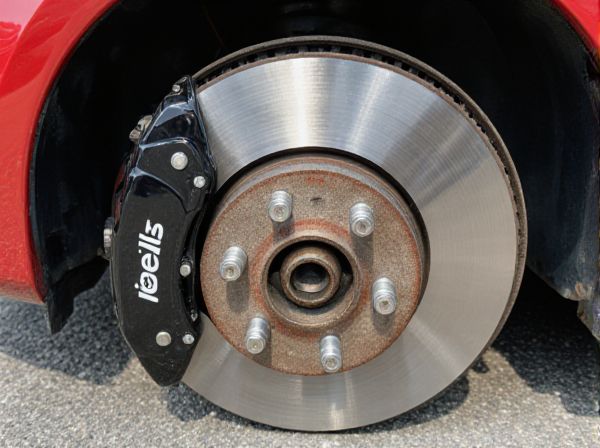
Photo illustration: Organic Pad vs Low-Metallic Pad
Organic brake pads offer quieter operation and better initial bite, making them a great choice for everyday driving where noise reduction is important. Low-metallic pads provide enhanced braking performance and heat dissipation but may generate more noise and dust. Your choice depends on whether you prioritize noise comfort or higher braking efficiency during demanding conditions.
Table of Comparison
| Feature | Organic Brake Pad | Low-Metallic Brake Pad |
|---|---|---|
| Material Composition | Natural fibers, resins, rubber | Organic materials with 10-30% metal content |
| Performance | Quiet, smooth braking | Strong stopping power, better heat dissipation |
| Wear and Tear | Higher wear rate, softer on rotors | Moderate wear, can cause rotor wear |
| Brake Dust | Produces more dust, softer dust | Less dust, but dust may be abrasive |
| Heat Resistance | Lower heat tolerance, fade in extreme conditions | Better heat resistance, reduced brake fade |
| Best Use | Daily driving, light vehicles | Performance cars, heavy-duty use |
| Cost | More affordable | Higher price point |
Introduction to Brake Pad Types
Organic brake pads are composed of a mixture of fibers, fillers, and binders, offering quieter operation and softer braking performance suitable for everyday driving. Low-metallic brake pads contain a higher percentage of metal fibers, enhancing heat transfer and braking efficiency but producing more noise and dust. Both types serve distinct purposes, with organic pads ideal for comfort and low wear, while low-metallic pads provide improved stopping power and durability under demanding conditions.
What Are Organic Brake Pads?
Organic brake pads are composed mainly of natural materials such as rubber, carbon compounds, glass, and resins, offering a quieter and less abrasive braking experience. These pads generate less dust and provide smoother engagement compared to low-metallic pads, making them ideal for everyday driving and lighter vehicles. Organic brake pads typically have a shorter lifespan and lower performance under extreme heat, which distinguishes them from the more heat-resistant and durable low-metallic brake pads.
What Are Low-Metallic Brake Pads?
Low-metallic brake pads contain a small percentage of copper or steel, typically 10-30%, blended with organic materials to improve heat transfer and braking performance. These pads offer enhanced braking power and better fade resistance compared to fully organic pads, making them suitable for higher performance or heavier vehicles. However, they tend to produce more noise and brake dust than organic pads, which may affect overall driving comfort and cleanliness.
Material Composition Comparison
Organic brake pads primarily consist of resin, rubber, carbon compounds, and small amounts of metal fibers, offering a softer and quieter braking experience. Low-metallic pads contain higher percentages of metallic elements such as copper or steel, which enhance heat dissipation and braking performance but may increase noise and wear. The material composition differences directly impact braking efficiency, durability, and noise levels, making each pad type suitable for specific driving conditions.
Performance Differences
Organic brake pads provide quiet operation and smooth stopping performance suitable for everyday driving, yet they tend to wear faster and produce more dust. Low-metallic brake pads incorporate small amounts of metal, enhancing heat dissipation and braking responsiveness, which improves performance under high-stress conditions. The increased metallic content in low-metallic pads results in better pedal feel but can generate more noise and rotor wear compared to organic pads.
Noise and Comfort Analysis
Organic brake pads typically produce less noise due to their softer compound, offering a quieter braking experience compared to low-metallic pads. Low-metallic pads contain metal particles that enhance heat dissipation but often generate more noise and vibration during braking. In terms of comfort, organic pads provide smoother and quieter stops, while low-metallic pads may feel slightly harsher yet deliver improved braking performance under high temperatures.
Dust and Cleanliness Factors
Organic brake pads produce significantly less dust compared to low-metallic pads, contributing to cleaner wheels and reduced maintenance efforts. Low-metallic pads contain higher metal content, which generates more abrasive dust that can accumulate quickly and require frequent cleaning to maintain wheel aesthetics. The lower dust emission of organic pads makes them a preferred choice for drivers prioritizing cleanliness and minimizing brake component wear.
Longevity and Wear Rates
Organic brake pads feature a softer compound that offers quieter operation but tend to wear out faster, making them less durable in high-stress conditions compared to low-metallic pads. Low-metallic pads incorporate metal particles, providing enhanced heat dissipation and improved longevity while maintaining effective braking performance under heavier loads. The wear rates of low-metallic pads are generally lower, resulting in longer service intervals and greater overall lifespan.
Cost and Value Considerations
Organic brake pads generally offer lower upfront costs, making them a budget-friendly option for everyday driving and standard vehicle maintenance. Low-metallic pads, while more expensive initially, provide enhanced braking performance and durability, potentially reducing long-term replacement frequency and associated labor costs. Evaluating the balance between initial investment and performance benefits helps determine the best value based on driving conditions and vehicle requirements.
Choosing the Right Brake Pad for Your Vehicle
Organic brake pads offer quieter operation and less wear on rotors, making them ideal for daily driving and lighter vehicles. Low-metallic pads provide better heat dissipation and stronger stopping power, suited for performance or heavier vehicles requiring aggressive braking. Selecting the right brake pad depends on driving conditions, vehicle type, and desired balance between noise, durability, and braking efficiency.
 caratoz.com
caratoz.com